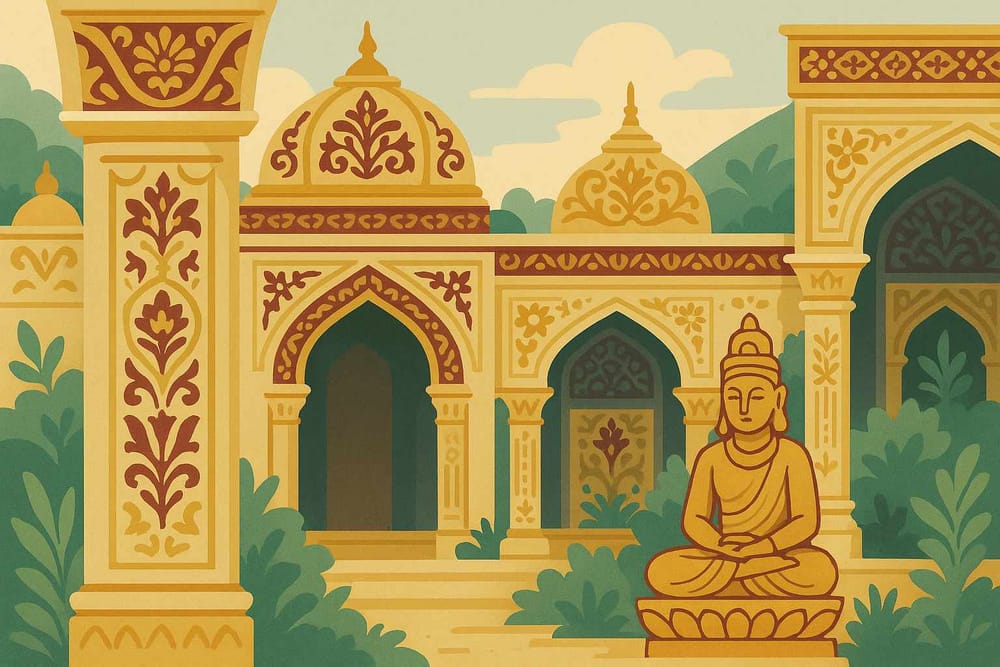
Kushano-Sasanian Influence Shapes Ancient Indian Architecture
Imagine travelling back in time, not to a place of conflict, but to an era where cultures met like rivers flowing into one another. This was the time of the Kushano-Sasanians, a period that often doesn't make it to our main history lessons but holds a treasure trove of stories. It was a time when the grandeur of the Persian Sasanian Empire found a home in the heart of ancient India, leading to a beautiful dialogue between two mighty civilisations. This exchange wasn't just about trade or power; it was a synthesis of ideas, spirituality, and art that forever changed the face of Indian architecture.
A Bridge Between Two Worlds: The Rise of the Kushano-Sasanians
To truly understand this fascinating period, we need to picture the world around the 3rd and 4th centuries CE. The once-great Kushan Empire was fading, and the powerful Sasanian Empire from Persia saw an opportunity. They extended their influence into regions like Bactria and Gandhara, establishing a unique sub-kingdom. The Sasanian governors who ruled these lands proudly took the title "Kushanshah," or "King of the Kushans," a clear nod to the blended world they now governed.
This wasn't just a change of rulers; it was the opening of a grand cultural highway. The Kushano-Sasanians became the custodians of the vital Silk Road arteries. This meant that it wasn't just silks and spices being exchanged, but also ideas, philosophies, and artistic techniques. Cities like Taxila became vibrant melting pots where a Persian artisan could share his craft with an Indian sculptor, creating something entirely new and breathtaking together.
New Designs on Ancient Lands: Persian Innovations in Indian Architecture
So, how did this cultural meeting translate into the buildings of that time? The influence was profound and can be seen in the very soul of the structures built during this era. The architects and artisans began to weave Persian design elements into the traditional Indian architectural fabric.
- Grand Domes and Arches: Suddenly, Indian temples and palaces began to feature majestic domes and vaulted ceilings, elements that were a hallmark of Persian design. These features didn't just add grandeur; they introduced new ways of thinking about space and light within sacred structures. You can feel this evolution in the spiritual energy and design of India's temple architecture, a legacy that continues to inspire awe.
- Stories Told in Stucco: The Kushano-Sasanians brought with them an expertise in intricate stucco work. Temple walls and monuments were adorned with delicate floral patterns, mythical winged figures, and mesmerising geometric shapes. This was a beautiful marriage of Persian artistic motifs with Indian symbolism, telling stories that everyone, regardless of their origin, could understand.
- Carving Mountains: The Persian tradition of carving monumental reliefs into rock faces, like those at Naqsh-e Rustam, deeply inspired Indian artists. This led to the creation of giant, awe-inspiring statues carved directly into mountains and cliffs, a practice that showcased both devotion and incredible skill.
A Harmony of Faiths and Arts
One of the most beautiful aspects of the Kushano-Sasanian era was the peaceful coexistence of different faiths. Zoroastrianism, the religion of the Sasanian rulers, found a place alongside Buddhism and Hinduism, which had deep roots in the land. This harmony is vividly captured in the art of the period. For instance, you might find a Zoroastrian fire altar represented in a temple's design, a testament to the respect and acceptance that defined the era.
This spirit of unity is something we at Bhaktilipi cherish deeply. Our mission is to preserve and share the timeless devotional stories and literature that form the soul of our culture. By exploring these historical connections, we can better appreciate the diverse threads that have woven our rich spiritual tapestry. If you wish to delve deeper into these traditions, we invite you to explore our platform, a digital space for today's devotee.
Unravelling the Mysteries of Kushano-Sasanian Art
People often wonder about the specific artistic styles of this period. The art was a true fusion. The coins minted by the Kushanshahs are like tiny canvases, often showing a king in Sasanian dress on one side and Indian deities or symbols on the other. Even murals from that time, like those found in the Ajanta caves, depict figures in distinct Sasanian attire, standing alongside a Hindu king. It’s a visual reminder of the interconnected world they lived in.
The question of what materials were used is also common. Artisans of the time were masters of stone, brick, and especially stucco, which allowed for incredibly detailed and expressive decorative work on both religious and secular buildings. This influence is most strongly seen in the architectural remains of northwest India, in regions that were at the heart of this cultural crossroad.
An Enduring Legacy of Unity
The Kushano-Sasanian chapter in our history is more than just a footnote; it's a powerful lesson in collaboration and creative exchange. It reminds us that our culture has always been dynamic, open to new ideas, and capable of creating extraordinary beauty from diversity. The arches, domes, and intricate carvings that whisper tales of this forgotten empire are a permanent part of India's architectural DNA.
As we stand in awe of our ancient monuments, let's remember the countless unnamed artisans and visionary rulers who built bridges between worlds. Their legacy teaches us that harmony isn't about erasing differences but celebrating them. It is this spirit of devotion and unity that we strive to keep alive.
To continue your journey through India's rich devotional and cultural heritage, we warmly invite you to subscribe to our YouTube channel and follow us on Facebook or Instagram. Join our community as we celebrate the stories that connect us all.
A passionate group of people dedicated to preserving India's knowledge of Dharma, Karma, and Bhakti for ourselves and the world 🙏.
